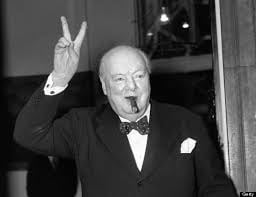Common Hand Gestures

Not all hand gestures are universally understood. These gestures have predominantly emerged in cultural settings. Hands are a complex design and its uses are both practicable and verbal. Hands frame and reinforce our verbal communication.
How many people do you know can sign language?

Victory, Peace and Harm
During World War II Winston Churchill displays the ‘V‘ for victory sign. This gesture historically marked a significant military achievement. This gesture is also a message of peace, therefore, Churchill is driving forth a dual meaning, victory and peace.
However, if this hand position is turned around: Australasia, United Kingdom and South Africa would consider this gesture an insult. It is evident that hand gestures like verbal language is unique to their country.
Thumbs Up!

On Hand
The thumbs up gesture communicates something is good or acceptable. This gesture was used by early Romans to indicate that a gladiator in the arena will live. In China the gesture means one. The thumbs up gesture is also used by hitch-hikers to get free transport from vehicles when hiking along the highway. The thumbs down gesture has a negative reaction and is not acceptable.
The vertical raised flat hand, palm facing the speakers face, signals, stay away, get back and stop talking. It’s a signal to a person that the listener is completely disinterested. And that they can just talk to the hand.
Shaking the fist at a person or group is a sign of defiance and can incite violence. It's a threatening message with the intention to intimidate a person or group.
The crossed fingers usually means hoping for the best. It also has a religious meaning to ward off evil and shun demons. Some people cross their fingers when telling lies to negate the lie. A flat hand extended and slightly tilted forward signals: stop, enough or calm down. The person is directing authority.
Throwing both hands in the air in most countries means to surrender or give during a criminal arrest or a complex situation.

Hold Hands
Holding hands is a cultural and biological behaviour. Most cultures have a standard when holding hands, although, it varies from culture to culture. Touching a sensitive part of the body in most cases is comforting and reassuring gesture. Psychologists have found that holding hands changes our behaviour. Hand holding relaxes muscles, calms your emotions and its a show of companionship, that we are not alone. It provides a feel good sensation.
Parents hold their child’s hand for practicable purposes. It is also a display of affection and comfort. Hand holding stems from infancy, and is carried on into adulthood. It’s a fond memory that in some way we want to replicate.
Men publicly hold hands in: Asian, African and Arabic countries. It is not considered a sign of romantic intimacy. But a genuine sign of friendship.
Group gatherings hold hands to reassure and strengthen the group members.
The Peace Sign

Sign Language
Technically, the term visual-manual modality is commonly called sign language. A manual communication.
Sign language is not a universal language, around the world we have our own unique verbal and sign language communication. Sign language is limited to geographical regions.
Yet, over one thousand deaf communities from different countries gathered. And were able to communicate.
In most countries sign language is recognised as an offical language.
Clean Hands

Hand Hygiene
In the year 1846, a Hungarian doctor, Ignaz Semmelweis, saved many lives through advocating hand hygiene. He found that doctors that did not wash their hands in a maternity ward the death rate was higher than women in the mid-wives clinic. Today, hand hygiene is commonplace.
Powerful Tools
For practicable purposes hands can: hold, carries, pull, push, rub, writes and much more. Our hands instinctively impact our conversation. Undoubtedly, the human hand is a powerful tool.
Links to visit ...
Rate this hub
- Certificate in Deaf Studies (Teaching New Zealand Sign Language) from Victoria University of Welling
Victoria University of Wellington, New Zealand. Has a Sign Language course for Certificate in Deaf Studies.
- British Sign Language - Wikipedia, the free encyclopedia
Sign language is not universal and each continent has its own sign language.
- ASL Browser
Welcome to the online version of the Personal Communicator. This is an online version of an American Sign Language Dictionary, which allows user to see what particular signs look.








